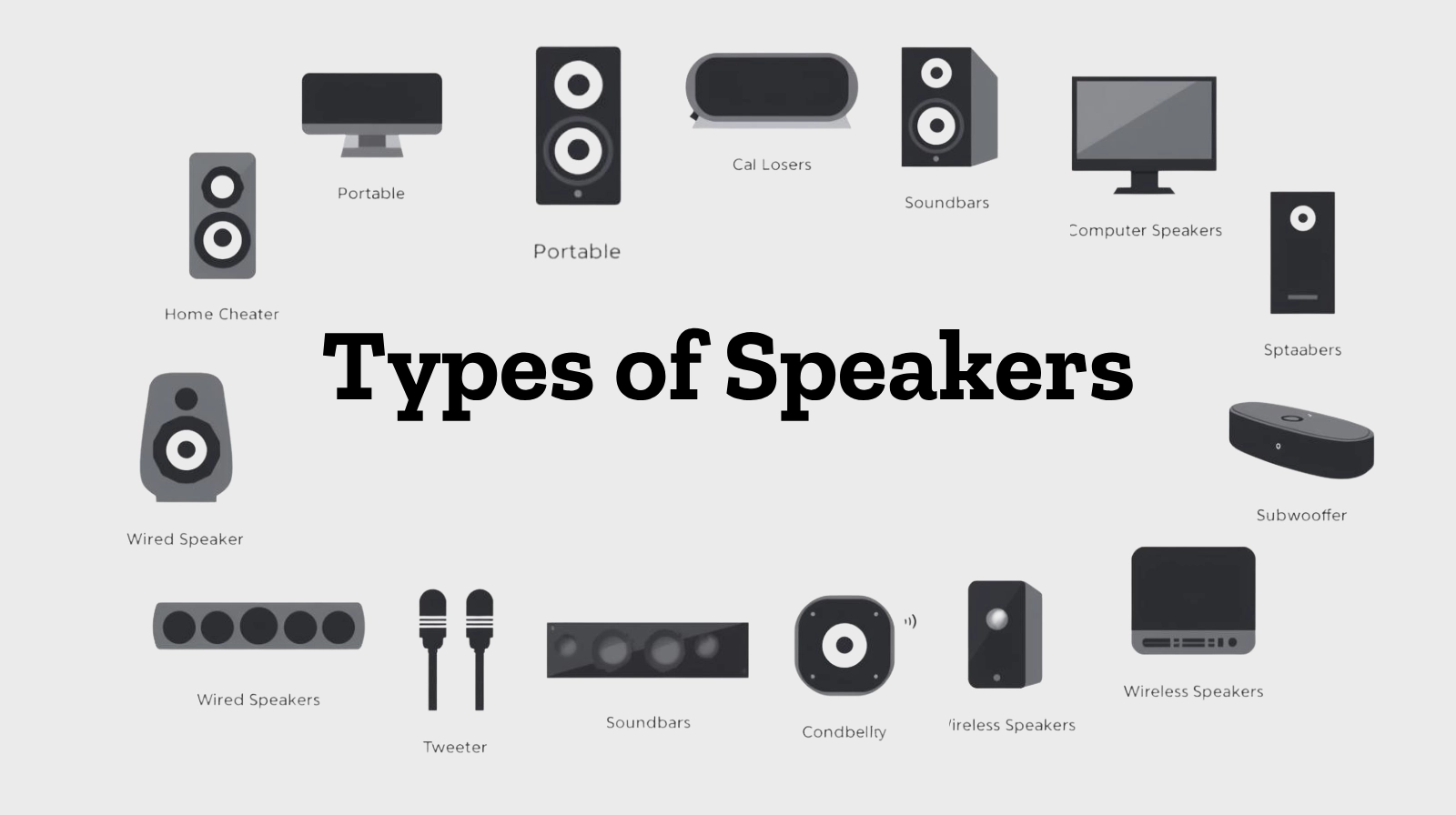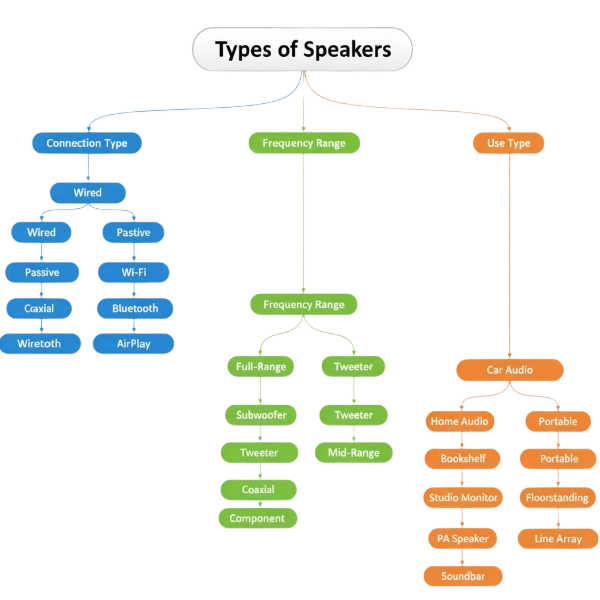Types of Speakers: A Quick Guide (2025)
Published: 13 Oct 2025
Have you ever listened to music on your computer or watched a movie on your laptop? The clear sound you hear comes from speakers! A speaker is a device that changes electrical signals into sound waves so we can hear music, voices, and effects clearly.
There are many types of speakers; some are small and fit on a desk, while others are large and powerful. You’ll also find computer speakers that connect to your PC or laptop for better sound quality.

In this article, we’ll learn what a speaker is, how it works, the main types of speakers, their advantages, disadvantages, and some FAQs. Let’s begin our simple sound journey!
What is a Speaker?
A speaker is an output device that converts electrical signals into sound waves that we can hear. It helps us enjoy music, videos, games, and all kinds of audio from our computer or other devices. This is the basic speaker definition used in computers and electronics.
- A speaker in a computer changes electrical signals into sound.
- It allows us to hear music, voices, and system sounds.
- It connects to the computer through wires or Bluetooth.
- It is a type of output device.
- The main job of a computer speaker is to produce clear sound.
Example:
Common examples of speakers are headphones, computer speakers, and Bluetooth speakers. All these devices work in the same way; they take electronic signals and turn them into sound we can hear.
Classification of Speakers
Speakers can be divided into different groups based on how they connect, what kind of sound they produce, and how they are used.

These groups help us understand the types of speakers more clearly.
- Based on Connection Type:
This classification depends on how the speaker connects to a sound source like a computer or a mobile device. Some speakers use wires, while others work wirelessly using Bluetooth or Wi-Fi. - Based on Frequency Range:
Speakers are also grouped by the range of sound they produce. Some handle low sounds (bass), some handle mid-range sounds, and others handle high sounds (treble). Together, they create a full and rich sound. - Based on Usage or Design:
This type focuses on where and how the speakers are used. For example, there are computer speakers, home theater speakers, and portable Bluetooth speakers, each designed for a specific purpose.
Types of Speakers Based on Connection Type
Speakers can connect to devices in different ways, mainly through wires or wirelessly. Choosing the right type depends on your needs, like sound quality, portability, and convenience.
Wired Speakers
Wired speakers connect to a computer or device using audio cables such as a 3.5mm jack, USB, or AUX. They provide stable sound quality with no delay, making them ideal for desktops, TVs, and music systems.
Example: Logitech Z213, Creative Pebble 2.0
Pros:
- Better sound quality
- No charging needed
Cons:
- Less portable
- Wire clutter
Wireless Speakers
Wireless speakers connect using Bluetooth, Wi-Fi, or NFC, allowing easy pairing with phones, laptops, or smart TVs. They are perfect for home, office, or travel use.
Example: JBL Flip, Bose SoundLink, Amazon Echo
Pros:
- Portable
- Cable-free
- Stylish design
Cons:
- Needs charging
- Possible signal delay
| Feature | Wired Speakers | Wireless Speakers |
| Connection | Cable (AUX/USB) | Bluetooth/Wi-Fi |
| Sound Quality | High and stable | Depends on the signal |
| Portability | Limited | Very portable |
| Power Source | Plug-in | Battery or rechargeable |
| Setup | Fixed | Easy and quick |
Types of Speakers Based on Frequency Range
Speakers can also be classified by the frequency range they produce. Different speakers handle low, mid, or high sounds to give a complete audio experience.
- Subwoofer:
A subwoofer produces deep bass or low-frequency sounds. It is commonly used in music systems, home theaters, and cars to add powerful rumble.
Example: Sony SA-D40, JBL BassPro Go
Simple Example: The “boom” sound in a movie comes from the subwoofer. - Woofer:
A woofer handles low and mid-range sounds (20–2000 Hz). It is usually part of larger speaker systems.
Example: Car audio systems, big speakers - Mid-Range Speaker:
A mid-range speaker produces human voices and musical instruments. Its frequency range is 200 Hz – 5000 Hz, which makes dialogues and music clear.
Example: TV and radio speakers - Tweeter:
A tweeter creates high-pitched sounds (5,000–20,000 Hz). It adds clarity and detail to music and movies.
Example: Home theater systems, studio monitors
| Speaker Type | Sound Range | Used For | Example |
| Subwoofer | Low (20–200 Hz) | Deep bass and beats | Home theaters |
| Woofer | Low–Mid (20–2000 Hz) | Music and rhythm | Car audio |
| Mid-Range Speaker | Medium (200–5000 Hz) | Vocals, instruments | TV speakers |
| Tweeter | High (5,000–20,000 Hz) | Sharp and clear sound | Studio monitors |
Types of Speakers Based on Usage and Design
Speakers are also classified by how they are used and their design. This helps us pick the right speaker for different needs, like travel, home, or car use.
- Portable Speakers:
Portable speakers are small, battery-powered, and easy to carry. They are perfect for outdoor activities, travel, or personal listening.
Example: JBL Go, Sony SRS-XB12 - Desktop or Computer Speakers:
Desktop or computer speakers are small speakers that connect to computers or laptops. They are designed for daily use, like music, video calls, and movies.
Example: Creative Pebble, Logitech Z150 - Home Theater Speakers:
Home theater speakers are big speaker sets that give a surround sound experience. They usually include woofer, subwoofer, and satellite speakers.
Example: Sony HT-S20R, Bose 5.1 - Soundbars:
Soundbars are long, bar-shaped speakers placed under TVs. They provide cinema-like sound without many wires.
Example: Samsung Soundbar, JBL Soundbar, Mi Soundbar - Smart Speakers:
Smart speakers have built-in AI assistants like Alexa or Google Assistant. They can answer questions, play music, or control smart devices.
Example: Amazon Echo, Google Nest Mini - Car Speakers:
Car speakers are specially designed for vehicles. They include tweeters, woofers, and subwoofers for clear and balanced sound.
Example: Pioneer car audio systems, JBL car audio systems
| Type | Main Use | Power Source | Example |
| Portable Speakers | Outdoor, travel | Battery | JBL Go |
| Computer Speakers | Desktop, laptop | Plug-in or USB | Logitech Z213 |
| Home Theater Speakers | Movies, music | Electric | Sony HT-S20R |
| Soundbars | TV audio | Electric | Samsung Soundbar |
| Smart Speakers | Voice control | Plug-in | Amazon Echo |
| Car Speakers | In-car audio | Vehicle power | Pioneer |
Specialized Types of Speakers
Some speakers are designed for specific purposes or spaces. These specialized speakers give better sound quality and suit different environments.
- Bookshelf Speakers:
Bookshelf speakers are medium-sized and placed on shelves or stands. They are perfect for small rooms or offices.
Example: Polk Audio T15, Klipsch R-41M - Floor-Standing Speakers:
Floor-standing speakers are tall and powerful, designed for large spaces. They deliver high-quality sound and strong bass.
Example: JBL Studio 580, Yamaha NS-F210 - Ceiling and Wall-Mounted Speakers:
Ceiling and wall-mounted speakers are installed in walls or ceilings to save space. They are common in theaters, conference rooms, and public areas.
Example: Bose Virtually Invisible 791, Klipsch CDT-5650-C II - Studio Monitors:
Studio monitors are used by music producers for accurate sound. They provide balanced and natural audio, helping professionals mix music correctly.
Example: Yamaha HS8, KRK Rokit 5
All Types of Speakers at a Glance
Speakers come in many varieties, and a speaker types chart makes it easy to understand the classification of speakers. This table shows the different kinds of speakers based on connection, frequency, usage, and design in a simple way for beginners.
| Category | Speaker Type | Purpose | Example |
| Connection Type | Wired, Wireless | How they connect | AUX, Bluetooth |
| Frequency Range | Subwoofer, Woofer, Tweeter | Sound type | Bass or Treble |
| Usage & Design | Portable, Smart, Soundbar | Function and placement | JBL, Alexa |
| Specialized | Bookshelf, Floor-standing | Professional use | Sony, Bose |
Conclusion
In this guide, we’ve explored the many types of speakers and how they work. Each speaker is made for different uses, from bass-heavy subwoofers to smart AI speakers. Choosing the right speaker depends on your needs, like studying, music, or movies.
Whether you prefer small Bluetooth speakers or big home theater sound, there’s a perfect speaker type waiting for you!
FAQs
Still have questions? Check out our FAQs below to find quick answers about the different types of speakers!
Stage 3 speakers are high-performance speakers used in large venues or concerts to deliver powerful and clear sound. They are designed to handle high volumes and cover wide audience areas effectively.
The classification of speakers divides them based on connection type, frequency range, and usage or design. This helps in choosing the right speaker for specific needs like music, movies, or travel.
The different types of speakers include wired and wireless, subwoofers, woofers, mid-range, and tweeters, as well as portable, computer, home theater, soundbars, smart, and car speakers. Each type serves a specific purpose for sound quality, placement, or portability.
The most common type of speaker is the computer or desktop speaker, used for daily activities like music, videos, and calls. They are small, easy to connect, and suitable for most home and office setups.
SL (Surround Left) and SR (Surround Right) speakers are part of a home theater or surround sound system. They provide immersive audio by delivering sound from the sides of the listener.
The main speaker is usually called the front or primary speaker in a sound system. It handles most of the audio, including dialogues, main vocals, and lead instruments.
Another name for a good speaker is a high-fidelity (Hi-Fi) speaker. It delivers clear, accurate, and balanced sound across all frequencies.
Articulacy is the ability to speak clearly and express ideas effectively. It shows how well someone can pronounce words and communicate their thoughts.

- Be Respectful
- Stay Relevant
- Stay Positive
- True Feedback
- Encourage Discussion
- Avoid Spamming
- No Fake News
- Don't Copy-Paste
- No Personal Attacks

- Be Respectful
- Stay Relevant
- Stay Positive
- True Feedback
- Encourage Discussion
- Avoid Spamming
- No Fake News
- Don't Copy-Paste
- No Personal Attacks





